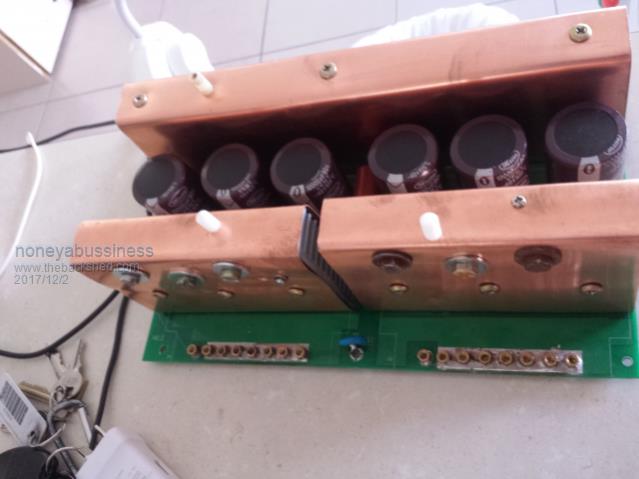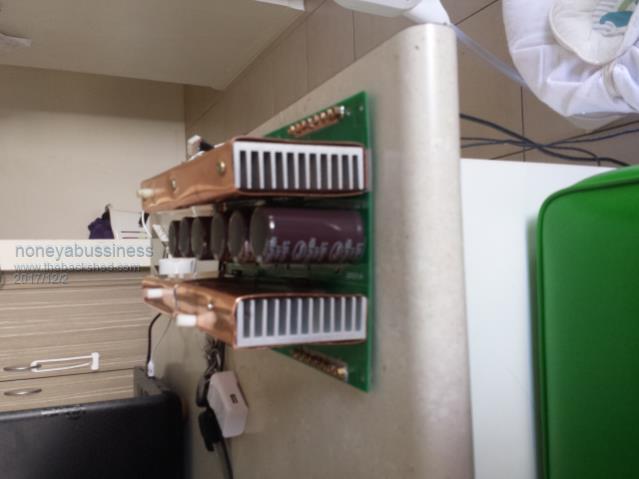
|

|
Forum Index : Electronics : Insulation Tape for Heatsinks
| Page 1 of 2 |
|||||
| Author | Message | ||||
Madness Guru Joined: 08/10/2011 Location: AustraliaPosts: 2498 |
Been searching everywhere but I can't find where I can buy single-sided adhesive tape for heatsinks. I need it for MOSFETs instead of fiddling around with lots of individual pads, I have seen it used in grid tie inverters. I bought some stuff from jaycar a while ago and it was like chewing gum. There are lots of double-sided adhesive tapes but that is useless as I need to be able to take it apart easily. There are only 10 types of people in the world: those who understand binary, and those who don't. |
||||
| yahoo2 Guru Joined: 05/04/2011 Location: AustraliaPosts: 1166 |
the company that makes the stuff you purchased from jaycar is Nitto Denko. it is called nitto self fusing butyl 15. It is about $15 a roll retail. I used to buy it in bulk from sciteq in Perth but if you are just after one roll I have seen it on the shelf in Bunnings. I dont think it is what you are after, you are meant to stretch and flex it as it is applied and use pressure and body heat from the fingers to make it amalgamate. Heat will make it deform and metal will push through the tape. it has no adhesive on it. Nitto do make a flame retardant tape for electrical work (also Bunnings, I just looked) I have not tried it but I think it would be more suitable. or polyester tape but I haven't got a stockist in my book for that one. I'm confused, no wait... maybe I'm not... |
||||
Madness Guru Joined: 08/10/2011 Location: AustraliaPosts: 2498 |
Thanks for the reponse Yahoo but the stuff from jaycar is crap for what I am trying to do. It needs to insulate at least 300VDC, that gooey chewing gum like stuff is not at all suitable, apart from that it sticks everything together. The tape needs to insulate the MOSFETs electrically and conduct heat at the same time, it is not insulation tape used for wrapping around wire like in your link. There are only 10 types of people in the world: those who understand binary, and those who don't. |
||||
| johnmc Senior Member Joined: 21/01/2011 Location: AustraliaPosts: 282 |
Good day 3M make a glass tape silicon adhesive 600v 200c. not cheap,designed for transformers RS stock it cheers john johnmc |
||||
Madness Guru Joined: 08/10/2011 Location: AustraliaPosts: 2498 |
Thanks John, This is for MOSFETs and needs to conduct heat but not conduct electricity. There are only 10 types of people in the world: those who understand binary, and those who don't. |
||||
| Tinker Guru Joined: 07/11/2007 Location: AustraliaPosts: 1904 |
Hi Mad, Check out this:tape Its not exactly what you are asking but it might do. I use it to insulate parts of the PCB underside from the heat sink fins. The tape is very thin and quite strong. I dare say it should conduct heat as well as a mica washer under a power transistor, etc. The tape comes in various widths, perhaps do some googling on its properties? Klaus |
||||
Madness Guru Joined: 08/10/2011 Location: AustraliaPosts: 2498 |
Hi Tinker, That is Kapton tape, I have that already. Seems the correct stuff is not available to the public, if the insulation breaks down (300+VDC) my GTI and inverter release their smoke. If the MOSFETs get too hot there is a similar effect. There are only 10 types of people in the world: those who understand binary, and those who don't. |
||||
oztules Guru Joined: 26/07/2007 Location: AustraliaPosts: 1686 |
try this https://www.aliexpress.com/item/BM120-Sil-Pad-Coated-Fiberglass-0-3mm-300mm-1m-Thermal-Silicone-Pad-For-Heat-Sink-IGBT/3 2832874362.html?spm=2114.search0104.3.17.ygCcOm&ws_ab_test=searchweb0_0,searchweb201602_4_10152_10065_10151_10344_10068_ 10130_10345_10342_10547_10343_10340_10341_10548_10541_10562_10084_10083_10307_10131_10132_10133_10539_5080015_10312_1005 9_10313_10314_10534_10533_100031_10604_10603_10103_10594_10557_10596_10595_10142_10107,searchweb201603_14,ppcSwitch_4&al go_expid=68ce5bf2-3d05-45f5-b118-18ba00c55d3e-2&algo_pvid=68ce5bf2-3d05-45f5-b118-18ba00c55d3e&rmStoreLevelAB=3 It is the sheets of the silicon rubber thermal fiberglass stuff we use for trannies and fets and igbt etc. It mentions that you can have adhesive or not. 11 dollars/meter seems dirt cheap. I would use the non adhesive, and just use the grease as a bonding agent to keep it in place. ... just bought some myself.  ........oztules Village idiot...or... just another hack out of his depth |
||||
Madness Guru Joined: 08/10/2011 Location: AustraliaPosts: 2498 |
Thanks Oz that is the ducks nuts thank you. That url does not work but I found it here. There are only 10 types of people in the world: those who understand binary, and those who don't. |
||||
oztules Guru Joined: 26/07/2007 Location: AustraliaPosts: 1686 |
Thanks.... I bought the BM9000 sil pad as well ( pink one ) it is 0.23mm one. Couldn't make up my mind which one. .......oztules Village idiot...or... just another hack out of his depth |
||||
Madness Guru Joined: 08/10/2011 Location: AustraliaPosts: 2498 |
I will stick with grey, some of the premium related silcone products at the bottom of the listing are a bit of an eye opener!  There are only 10 types of people in the world: those who understand binary, and those who don't. |
||||
| Warpspeed Guru Joined: 09/08/2007 Location: AustraliaPosts: 4406 |
Part of the problem is that the tab on the mosfet is so very small, and its difficult to get both good thermal conductivity and a high insulation breakdown voltage. One way around this is to use a 6mm thick copper sandwich block. Bolt the mosfet direct onto the copper block for highest possible thermal conductivity. Then insulate the copper block from the aluminium heatsink by the method of your choice. This has several advantages. The copper block can be made to have a relatively much larger footprint which will conduct heat a lot more readily. Mosfets can be changed without disturbing or damaging the thermal insulation, and the mosfets can probably be installed dry without thermal grease, direct copper to copper. Copper has a much higher thermal conductivity than aluminium, and the temperature gradient directly under the mosfet tab will be as low as is achievable with anything practical. Obviously several paralleled mosfets can share a common copper block which can be very convenient. I did some back to back testing a very long time ago, and do not now still have the original results. Fitting a thermocouple under the head of the mounting screw on top of the mosfet can be quite revealing. I now use 6mm thick copper blocks on anything where power dissipation gets really high. Usually 25mm x 35mm per device works well. Cheers, Tony. |
||||
Madness Guru Joined: 08/10/2011 Location: AustraliaPosts: 2498 |
I am using TO247 package MOSFETs so it has a bigger surface area, no sharp metal corners and a more central screw hole compared to TO220 devices. There are only 10 types of people in the world: those who understand binary, and those who don't. |
||||
| Warpspeed Guru Joined: 09/08/2007 Location: AustraliaPosts: 4406 |
TO227 packages are definitely a very big step in the right direction. There are several varieties of TO247 that have a heat transfer area through the copper base of between about 168mm^2 and 300mm^2 TO220 is about a piddling 100mm^2 A 25mm x 38mm copper block with 950mm^2 just has to be better. The thermal conductivity through the insulator then becomes far less important. You can make the copper blocks much larger still, but I found 25mm x 38mm per device is a practical size, and into the point of diminishing returns. Cheers, Tony. |
||||
| Tinker Guru Joined: 07/11/2007 Location: AustraliaPosts: 1904 |
Interesting idea Tony, have you or anybody else seen suitable copper blocks on ebay? Seems to me there could be a market for these. So, the mosfet, etc. is fitted to the block with a single screw. If this same screw also holds the copper block it would need to be fairly well torqued on. Unfortunately the hole in TO247 devices is only 3.5mm. M3.5 is an odd screw size, I found 4BA is very close and that is what I use on my inverter mosfets. I think M3 is a bit on the small size to secure the copper block as well and ensure adequate pressure. Klaus |
||||
| Warpspeed Guru Joined: 09/08/2007 Location: AustraliaPosts: 4406 |
I have odd scraps of 6mm copper here that I saw up as required. Rectangular hard drawn copper bar is available fairly readily for use as electrical busbars. That can be drilled and tapped, and is much more robust than aluminium for threading. Alan headed "unbrako" screws in 3mm are very high tensile and strong, way more than is needed. But an Alan key can sometimes reach where a screwdriver will not. So for that reason alone Alan screws can be quite useful. I doubt if anyone is making these copper blocks, and its really too expensive to do commercially. But we DIY hobby types can build and engineer superior equipment, especially if we recycle things we can find at the scrap metal, and spend hours tapping holes and adding nice features that would never be considered worth the trouble for mass produced equipment built down to a price. Cheers, Tony. |
||||
Madness Guru Joined: 08/10/2011 Location: AustraliaPosts: 2498 |
I bought a 40 X 15 X 200 copper bar on Ebay a while ago, I used it to make a negative busbar. It was listed for hobbyist/machining. For the charge controller I am working on I don't think there is any need to add copper as the MOSFETs are not getting that hot anyway. There are only 10 types of people in the world: those who understand binary, and those who don't. |
||||
| Warpspeed Guru Joined: 09/08/2007 Location: AustraliaPosts: 4406 |
Its only really an advantage where the absolute limits of power dissipation (per device) are being pushed. For many conservatively designed higher power applications that work efficiently, only minimal heat sinking may be required anyway, and its just not worth the extra effort involved. The copper block idea is an extreme solution that may one day get you out of trouble where the alternatives are few, so is worth knowing about. Cheers, Tony. |
||||
| noneyabussiness Guru Joined: 31/07/2017 Location: AustraliaPosts: 513 |
https://rover.ebay.com/rover/0/0/0?mpre=https%3A%2F%2Fwww.ebay.com.au%2Fulk%2Fitm%2F142469454110 I have used these in the past.. handy for pushing a bit more heat through. .. early PJ board for the big 10kw one, i overlaid copper sheet on the original heat sinks... combination of copper and ally was extremely effective. .. I think it works !! |
||||
| noneyabussiness Guru Joined: 31/07/2017 Location: AustraliaPosts: 513 |
  Couple of pics of what I mean I think it works !! |
||||
| Page 1 of 2 |
|||||